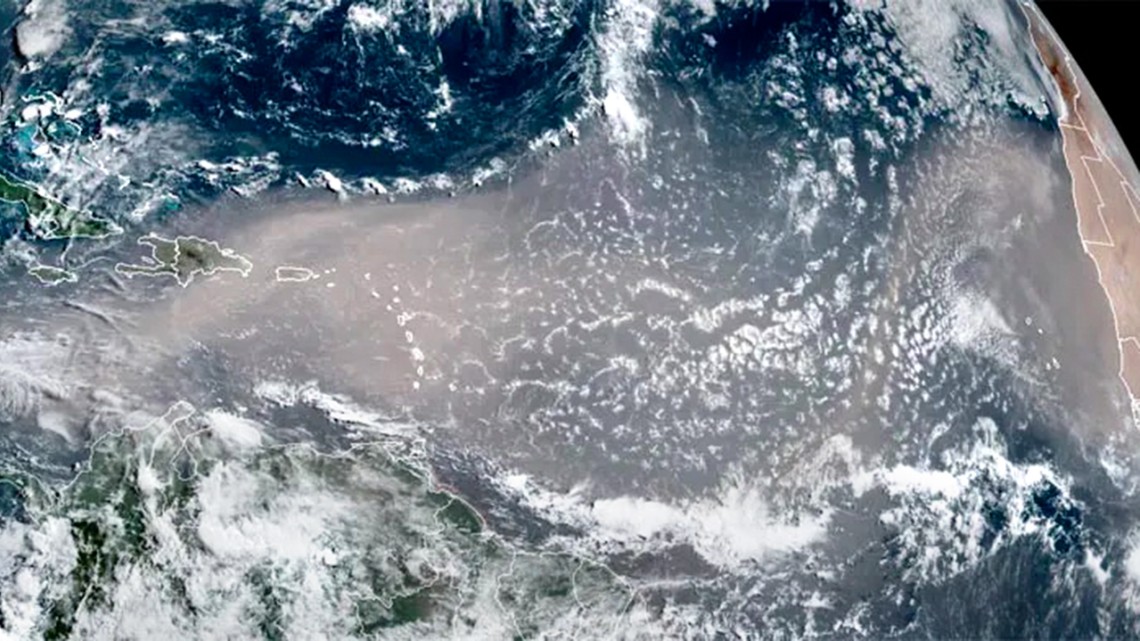
African dust cloud over the Atlantic Ocean as seen by the GOES-17 satellite June 22, 2020.
Live plant pathogens can travel on dust across oceans
By Krishna Ramanujan, Cornell Chronicle
Plant pathogens can hitch rides on dust and remain viable, with the potential for traveling across the planet to infect areas far afield, a finding with important implications for global food security and for predicting future outbreaks.
A study, “Assessing Long-distance Atmospheric Transport of Soilborne Plant Pathogens,” published Sept. 25 in the journal Environmental Research Letters, is the first to provide computer modeling evidence to support the idea that massive dust storms can transport viable pathogenic spores across continents and oceans.
The Earth system model simulated a major dust storm, nicknamed “Godzilla,” that brought some 24 million tons of dust from North Africa across the Atlantic Ocean to the Caribbean and southeastern United States in summer 2022.
The researchers found that viable spores of the deadly fungal plant pathogen Fusarium oxysporum (F. oxy) could be transported across the ocean and were likely deposited across a range of regions that include agricultural production zones, most significantly in southeastern Louisiana, Mexico, Haiti and the Dominican Republic, with particularly high risk in Cuba.
“We found that this Godzilla dust event could have potentially brought over 13,000 viable live spores, which is not a lot, but it’s never been shown before, by any means, that viable soilborne pathogens could be transported trans-oceanically with dust,” said study co-author Kaitlin Gold, assistant professor of plant pathology in the College of Agriculture and Life Sciences at Cornell AgriTech and lead principal investigator on the NASA Interdisciplinary Sciences grant that funded this research.
The modeling effort included previous research of F. oxy viability to show that 99% of all spores are killed off within three days of being airborne due to ultraviolet radiation exposure, a factor that was included in the model along with variable spore size, weight and density.
“For long distance transport, when we just look at total spores, including ones that maybe deactivated while they’re in the atmosphere, we see there are many that are traveling very long distances,” said Hannah Brodsky ‘22, the paper’s first author, who conducted the work as an undergraduate in the lab of Natalie Mahowald, the study’s senior author and the Irving Porter Church Professor in Engineering in the Department of Earth and Atmospheric Sciences in Cornell Engineering.
“What really limits potential disease spread via long-distance transport is whether they're still viable by the time they land in an agricultural region,” Brodsky said.
The researchers also looked at intercontinental transport, areas closer to the source – where spores might be airborne for less time – that likely received the majority of the viable spore depositions.
“There are certain regions of the globe where transport of viable spores is more likely to happen, for example, between Europe, Asia and Northern Africa,” Brodsky said.
These areas bear the most risk because of the probability that farmers would grow common crops near where dust and pathogens originate, Gold said.
Soil-adapted F. oxy is found on all six crop-producing continents and can infect more than 100 crops and other plants, leading to losses of up to 60% of crops and hundreds of millions of dollars in some areas.
As a result, understanding how fungal diseases spread and identifying agricultural zones where viable spores could deposit is vitally important to ensure global food security, according to the paper.
Though F. oxy is soil adapted and not equipped to survive well when airborne, researchers have found that the pathogens attach to soil particles in dust clouds.
In the study, co-author Rocío Calderón, NASA-funded postdoctoral research associate at Cornell University, contributed extensively to an exhaustive literature search with more than 1,100 references for different species to create an interactive web map that showed variable spore concentrations in soils. This data improved the accuracy of the model’s results by an order of magnitude, compared with uniform distributions of spores used in early versions.
The researchers found that sub-Saharan Africa was a source for 53% of all viable spores and 14% of viable spores that travelled across the Atlantic.
“This is the region that should likely be targeted for addressing the disease,” Gold said.
The researchers note that the study is preliminary, with future work focused on gathering observational data for corroborating the model’s results – including creating remote sensing maps of dust storms and genomic comparisons of F. oxy between dust sources and areas of disease outbreaks.
Sharifa Crandall, a plant pathologist at Pennsylvania State University, and Ryan Pavlick, a research technologist at NASA Jet Propulsion Lab, are co-authors. Brodsky is currently a researcher at the National Renewable Energy Lab in Golden, Colorado.
The study was funded by NASA.
Media Contact
Get Cornell news delivered right to your inbox.
Subscribe
